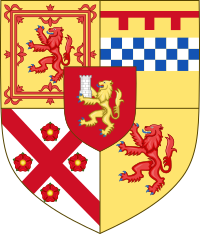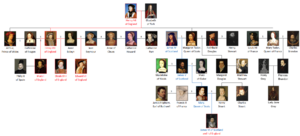Henry Stewart, 1st Lord Methven facts for kids
Quick facts for kids
Henry Stewart
|
|
|---|---|

Arms of Henry Stewart, 1st Lord Methven.
|
|
| Born | c. 1495 |
| Died | c. 1552 |
| Title | 1st Lord Methven |
| Spouse(s) |
|
| Parent(s) | Andrew Stewart, 1st Lord Avondale Margaret Kennedy |
Henry Stewart, 1st Lord Methven (born around 1495 – died 1552) was an important Scottish nobleman. He was in charge of Scotland's cannons and other big guns, known as the Master of the Scottish Artillery. He was also the third and last husband of Margaret Tudor. Margaret was the oldest daughter of Henry VII of England and Elizabeth of York. She was also the mother of James V of Scotland.
Contents
Henry Stewart's Family History
Henry Stewart was the son of Andrew Stewart, 1st Lord Avondale. His mother was Margaret Kennedy. His brother was Andrew Stewart, 1st Lord Ochiltree. Henry came from a long line of important Scottish families. He was related to Murdoch Stewart, 2nd Duke of Albany. This made him a distant cousin of James IV of Scotland, who was Margaret Tudor's first husband.
Marriage to the Queen Mother
Henry Stewart became good friends with Margaret Tudor, the Queen Mother of Scotland. Their friendship was first noticed in 1524. Because of this friendship, he was given important jobs. He became the master carver for young King James V. He also became the Master of Artillery, in charge of all the cannons.
Henry and Margaret Tudor got married on March 3, 1528. Margaret had worked hard to get a divorce from her second husband, Archibald Douglas, 6th Earl of Angus. The Pope finally allowed her divorce in March 1527. Margaret already had two children: James V of Scotland from her first marriage, and Margaret Douglas from her second. Henry and Margaret Tudor did not have any children together.
Their marriage caused some trouble right away. Margaret and Henry were surrounded at Stirling Castle by Lord Erskine. King James V and Margaret's former husband, the Earl of Angus, supported this action. Henry was even put in prison for a short time.
However, things changed when King James V escaped from the Douglas family. He joined his mother at Stirling Castle. After this, Henry was given the title of Lord Methven. Margaret also made him the captain of her castle of Newark. In 1539, Henry and Margaret rented out their coal mine at Skeoch. The rent was 100 loads of coal for Margaret's home at Stirling Castle.
Henry Stewart's Second Marriage
Margaret Tudor wanted to end her marriage to Henry Stewart for personal reasons. However, her son, King James V, did not agree to it at first. After Margaret Tudor died in 1541, Lord Methven was able to marry Janet Stewart. Janet was the daughter of John Stewart, 2nd Earl of Atholl.
Henry and Janet had four children together:
- Henry Stewart, 2nd Lord Methven (died in 1572).
- Dorothea Stewart, who married William Ruthven, 1st Earl of Gowrie.
- Joan Stewart, who married Colin Campbell, 6th Earl of Argyll.
- Margaret Stewart. She married twice.
Master of the Royal Artillery
On September 10, 1524, Lord Methven was made the Principal Master of the Royal Artillery. This meant he was the chief officer in charge of all the cannons and war machines for Scotland. About 25 years later, he led the Scottish artillery during the Siege of Haddington.
During a war called the Rough Wooing, Lord Methven wrote to Queen Mary of Guise in 1547. Mary of Guise was the widow of King James V. Methven wrote to her about how to use cannons in the war. He explained that using cannons poorly could make people lose faith in the army. He also said that to capture places like Broughty Castle from the English, more cannons were needed. He asked for French military leaders who knew how to use artillery well.
Lord Methven wrote to Mary of Guise again in 1548. He gave her advice on how to unite Scotland. He said he had friends all over Scotland and knew why some Scots supported the English. He believed many Scots favored the English due to different reasons, including fear or a belief that English rule might be better. He suggested that instead of punishing these people, it would be better to offer a general pardon. He thought this would help bring Scotland together. He believed the Scottish defeat at the Battle of Pinkie was partly due to these reasons and the army's disorganization.
He also reported that news traveled fast. People in Perth already knew that the Scottish cannons at Broughty Castle would be moved to the Siege of Haddington. The people of Perth hoped a French army would protect them from the English soldiers at Broughty. Lord Methven personally helped move the cannons. He used 240 oxen to drag the heavy guns through his lands. At Haddington, he reported that the cannons were working well. However, a French officer later ordered the guns to be pulled back. As English reinforcements arrived, Methven moved the Scottish and French cannons to Edinburgh and Leith for repair.



